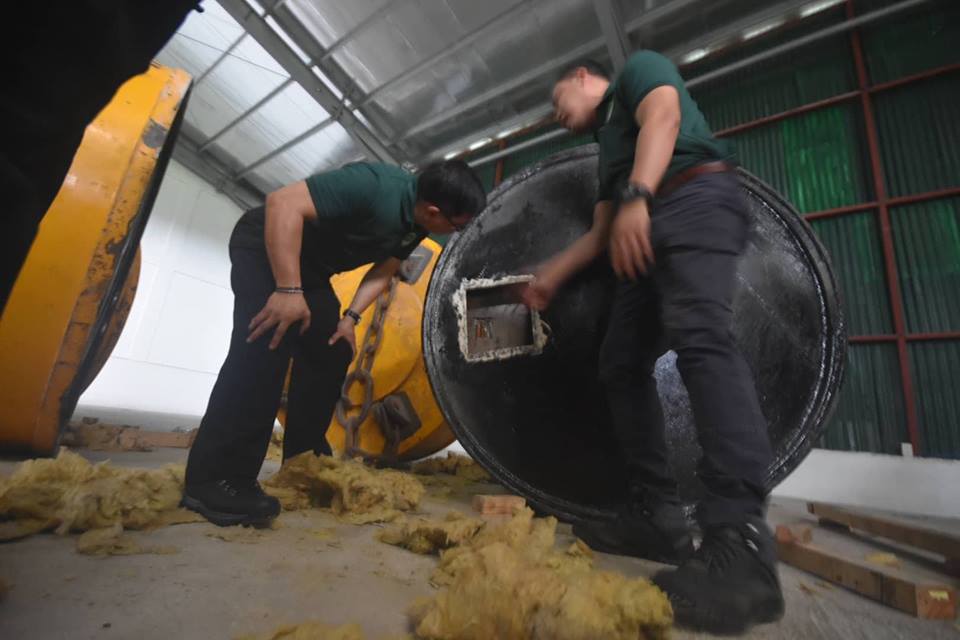Another Drug Shipment Slips Through: Media Miss What It Says About The “Drug War”

Philippine Drug Enforcement Agency Director General Aaron Aquino inspects the seized magnetic lifters in Cavite. | Photo from PDEA Top Stories Facebook page.
ON AUGUST 10, operatives from the Philippine Drug Enforcement Agency (PDEA), the Bureau of Customs (BOC) and the police seized four magnetic lifters in a warehouse in General Mariano Alvarez, Cavite suspected of containing about one ton (1,000 kilograms) of “shabu” (methamphetamine) worth PHP6.8 billion. But the hollowed-out lifters had already been emptied, with drug-sniffing dogs detecting merely traces of the contraband.
“This is very saddening. PHP6.8 billion worth of illegal drugs are now circulating anew in our streets,” PDEA Director General Aaron Aquino said during a press briefing on the same day.
PDEA had earlier intercepted on August 7 a drug shipment of at least 500 kilograms of shabu worth PHP4.3 billion at the Manila International Container Terminal. The contraband was in two magnetic lifters similar to those seized in Cavite.
This was not the first time a large drug shipment had slipped past authorities. In May 2017, PHP6.4 billion worth of shabu initially made it through the BOC but was later seized by Customs authorities led by then Commissioner Nicanor Faeldon. The incident prompted simultaneous inquiries from the House of Representatives and the Senate (see monitor: “Customs Under Fire: Shabu from China on the “green lane”“).
Media reported the developments, highlighting the conflicting claims of PDEA and the BOC in the August 10 incident. The coverage relied only on the statements of the parties involved, which did not help provide the information that could help explain the implications of the drugs’ making it through Customs.
CMFR monitored reports from the Manila broadsheets Manila Bulletin, the Philippine Daily Inquirer and The Philippine Star; the primetime newscasts 24 Oras (GMA-7), Aksyon (TV5), News Night (CNN Philippines) and TV Patrol (ABS-CBN 2); as well as selected news websites from August 10 to August 20, 2018.
A Quick Pass
Initial reports on the fiasco appeared in online news sites and evening newscasts on August 10; the newspapers followed suit the next day. The reports recalled PDEA’s press briefing during which the agency’s initial findings were announced. The subject, however, was sidelined in the weekend by reports on tropical storm Karding.
The topic regained media attention on August 14 when the House Committee on Dangerous Drugs began its probe. By August 16, television news had dropped the subject, with only the newspapers and online accounts continuing the coverage. However, subsequent reports barely contained useful information and remained focused on the views of government officials on the matter. Only a brief report by the Inquirer noted the Cavite townsfolk’s belief that there really were drugs in the lifters.
Focus On PDEA And BOC
The reports focused on statements made by PDEA and BOC. During the House probe, Customs Commissioner Isidro Lapeña said the seized containers had “yielded negative results for the presence of dangerous drugs.” But Ruel Lasala, PDEA deputy director for operations, disputed Lapeña, arguing that “circumstantial evidence” proved there were drugs in the magnetic lifters.
The reports failed to check the validity of the claims by both sides, and to raise such questions about the capacity of the BOC, PDEA and PNP, working together, to detect illegal drugs and prevent its entry. Media should examine how effective the drug war can be, if indeed these agencies do not have the necessary equipment and other means of detection. The reports could have helped provide the answers by interviewing experts knowledgeable in the process of detecting illegal drugs. As the main program of the Duterte administration, this development shows that the government has not actually not prepared for it, concentrating instead on the elimination of suspected drug users and pushers rather than targeting their sources.
Only Rappler on August 14 highlighted this concern when it reported the explanation of Zsae Carrie de Guzman, BOC’s x-ray scanning chief, during the House inquiry. De Guzman told congressmen that with their current machines, the BOC cannot scan for illegal substances wrapped in lead, foil and plastic.
Duterte’s Indifference (Again)
The fiasco was a blow on the government’s war on drugs, which Duterte said in July would be as “relentless and chilling” as it had begun in 2016. But the president appeared cool to the blunder, a response similar to his reaction to the drug smuggling fiasco at the BOC in 2017. As someone who regularly professes his hate for illegal drugs, Duterte seemed awfully calm about a ton of shabu making it to the streets.
But media reports did not make much of this indifference, settling instead for the usual response from Presidential Spokesperson Harry Roque who said Duterte could be speaking from the perspective of a lawyer.
Media also noted that PDEA chief Aquino took leave in the heat of the issue, unable to attend even the House hearing that probed the case. It was left to Roque and Ana Marie Banaag, Communications Assistant Secretary, to clarify that he had not resigned but was on leave, which had been scheduled earlier. The president remained silent on this as well.
Duterte’s controversial war on drugs has proven to be deadly, with thousands upon thousands of suspects killed in just two years – the numbers varying depending on who’s talking. The media should have highlighted the need to reevaluate the methods being used to curb the proliferation of illegal drugs.
Leave a Reply